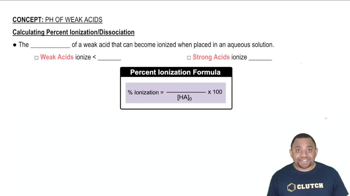Textbook Question
A 0.185 M solution of a weak acid (HA) has a pH of 2.95. Calculate the acid ionization constant (Ka) for the acid.
1
views

 Verified step by step guidance
Verified step by step guidance


A 0.185 M solution of a weak acid (HA) has a pH of 2.95. Calculate the acid ionization constant (Ka) for the acid.
Determine the percent ionization of a 0.125 M HCN solution.
Determine the percent ionization of a 0.225 M solution of benzoic acid.
Calculate the percent ionization of a formic acid solution having the given concentration. a. 1.00 M
Calculate the percent ionization of a formic acid solution having the given concentration. b. 0.500 M
Calculate the percent ionization of a formic acid solution having the given concentration. c. 0.100 M